Enabling Energy Harvesting-Based Wi-Fi System for an e-Health Application: A MAC Layer Perspective
Abstract
:1. Introduction
- We conduct extensive simulations in the Network Simulator 3 (ns-3) environment, which can accurately mimic the deployment of Wi-Fi communication for solar-based medical devices in the proposed scenario.
- We incorporate the AP coordination idea from the upcoming IEEE 802.11be standard in our AP coordination-based optimization approach, while also maintaining backward compatibility with the IEEE 802.11 standard.
- We propose an objective function based on medical-grade QoS criteria and energy usage.
- We propose a sleep/wake-up mechanism that puts non-AP stations to sleep for a time interval if residual energy falls below a particular threshold. This approach allows network energy consumption reduction while maintaining the desired level of QoS.
2. Background Study
2.1. E-Healthcare
2.2. IEEE 802.11
2.2.1. Previous IEEE 802.11 Amendments
2.2.2. Wi-Fi 7
2.3. Energy Harvesting in E-Healthcare
3. Related Work
3.1. MAC Layer Modification
3.2. Integration of the Energy Harvesting Technologies with Wi-Fi
3.3. Energy Harvesting MAC Layer Protocols
4. Methodology
4.1. AP Coordination-Based Optimization Algorithm
4.2. Sleep/Wake-Up Mode
4.3. System Model
4.4. Evaluation Metrics
4.4.1. End-to-End Delay
4.4.2. Throughput
4.4.3. FER
4.4.4. Collision Rate
4.4.5. PLR
4.4.6. Fairness
4.4.7. Objective Function
5. Simulation Setup
5.1. Network Scenario Definition and Assumptions
| Parameter | Value |
|---|---|
| Wireless Standard | IEEE 802.11n |
| Frequency band | 2.4 GHz |
| Physical transmission rate | MCS 5 for data frames |
| Propagation loss model | Hybrid building propagation loss |
| External Wall penetration loss | 7 dB |
| Internal Wall penetration loss | 4 dB |
| Transmission power | 16 dBm |
| Energy detection threshold | −62 dBm |
| CCA mode1 threshold | −82 dBm |
| Guard interval | Short |
| Channel bandwidth | 20 MHz |
| Channel Number | 1 |
| Aggregation | Disable |
| Stations per AP | 5 |
| Traffic Type | ECG | EEG | EMR | Telemetry Alarm |
|---|---|---|---|---|
| Access Category | BE | BE | BE | VO |
| Traffic model | ON-OFF | ON-OFF | ON-OFF | ON-OFF |
| (0.650–0.350) | (0.29–0.71) | (0.05–0.95) | (0.001–0.999) | |
| CBR [72] | CBR [40] | Exponential [40] | Exponential [40] | |
| Data rate | 12 kbps [71] | 32 kbps [73] | 4.1 Mbps [40] | 5 kbps [40] |
| Packet size (Bytes) | 147 [40] | 155 [73] | 1528 [40] | 668 [74] |
5.2. Energy Consumption of Each Transmission State
6. Performance Evaluation and Discussion
6.1. Adaptation to the CW Changes on All the Cells
6.1.1. CW Changes under ECG Application
6.1.2. CW Changes under EEG and EMR Applications
6.2. Adaptation to CW Changes on Slave Cells
6.2.1. CW Changes under ECG Application
6.2.2. CW Changes under EEG and EMR Applications
6.3. Adaptation to CW Changes on Master Cells
6.3.1. CW Changes under ECG and EEG Applications
6.3.2. CW Changes under EMR Application
6.4. Sleep/Wake-Up Mode with CW Changes
6.5. Impact of Energy Harvester
6.6. Discussion
7. Conclusions and Future Works
Author Contributions
Funding
Institutional Review Board Statement
Informed Consent Statement
Data Availability Statement
Conflicts of Interest
References
- Lee, I.; Lee, K. The Internet of Things (IoT): Applications, investments, and challenges for enterprises. Bus. Horizons 2015, 58, 431–440. [Google Scholar] [CrossRef]
- Cisco, U. Cisco Annual Internet Report (2018–2023) White Paper. 2020. Available online: https://www.cisco.com/c/en/us/solutions/collateral/executive-perspectives/annual-internet-report/whitepaper-c11-741490.html (accessed on 26 March 2021).
- Kashani, M.H.; Madanipour, M.; Nikravan, M.; Asghari, P.; Mahdipour, E. A systematic review of IoT in healthcare: Applications, techniques, and trends. J. Netw. Comput. Appl. 2021, 192, 103164. [Google Scholar]
- Famitafreshi, G.; Afaqui, M.S.; Melià-Seguí, J. A Comprehensive Review on Energy Harvesting Integration in IoT Systems from MAC Layer Perspective: Challenges and Opportunities. Sensors 2021, 21, 3097. [Google Scholar] [CrossRef] [PubMed]
- IEEE Standard Association. IEEE Standard for Wireless LAN Medium Access Control (MAC) and Physical Layer (PHY) Specification. 1999. Available online: http://standards.ieee.org/getieee802/802.11.html (accessed on 10 April 2022).
- Wang, X.; Yang, K. A real-life experimental investigation of cross interference between wifi and zigbee in indoor environment. In Proceedings of the 2017 IEEE International Conference on Internet of Things (iThings) and IEEE Green Computing and Communications (GreenCom) and IEEE Cyber, Physical and Social Computing (CPSCom) and IEEE Smart Data (SmartData), Exeter, UK, 21–23 June 2017; pp. 598–603. [Google Scholar]
- IEEE Std 802.11ax-2021 (Amendment to IEEE Std 802.11-2020); IEEE Standard for Information Technology–Telecommunications and Information Exchange between Systems Local and Metropolitan Area Networks–Specific Requirements Part 11: Wireless LAN Medium Access Control (MAC) and Physical Layer (PHY) Specifications Amendment 1: Enhancements for High-Efficiency WLAN. IEEE Standard Association: Piscataway, NJ, USA, 2021; pp. 1–767. [CrossRef]
- Zhong, Z.; Kulkarni, P.; Cao, F.; Fan, Z.; Armour, S. Issues and challenges in dense WiFi networks. In Proceedings of the 2015 International Wireless Communications and Mobile Computing Conference (IWCMC), Dubrovnik, Croatia, 24–28 August 2015; pp. 947–951. [Google Scholar]
- Afaqui, M.S.; Garcia-Villegas, E.; Lopez-Aguilera, E. IEEE 802.11 ax: Challenges and requirements for future high efficiency WiFi. IEEE Wirel. Commun. 2016, 24, 130–137. [Google Scholar] [CrossRef]
- Afaqui, M.S.; Garcia-Villegas, E.; Lopez-Aguilera, E.; Smith, G.; Camps, D. Evaluation of dynamic sensitivity control algorithm for IEEE 802.11 ax. In Proceedings of the 2015 IEEE wireless communications and networking conference (WCNC), New Orleans, LA, USA, 9–12 March 2015; pp. 1060–1065. [Google Scholar]
- Tian, S.; Yang, W.; le Grange, J.-M.; Wang, P.; Huang, W.; Ye, Z. Smart healthcare: Making medical care more intelligent. Glob. Health J. 2019, 3, 62–65. [Google Scholar] [CrossRef]
- Alvarez, R.C. The promise of e-Health—A Canadian perspective. Ehealth Int. 2002, 1, 4. [Google Scholar] [CrossRef] [Green Version]
- Gunther, E. What is e-Health? J. Med. Internet Res. 2001, 3, e20. [Google Scholar]
- Sodhro, A.H.; Malokani, A.S.; Sodhro, G.H.; Muzammal, M.; Zongwei, L. An adaptive QoS computation for medical data processing in intelligent healthcare applications. Neural Comput. Appl. 2020, 32, 723–734. [Google Scholar] [CrossRef]
- Akhtar, N.; Rahman, S.; Sadia, H.; Perwej, Y. A Holistic Analysis of Medical Internet of Things (MIoT). J. Inf. Comput. Sci. 2021, 11, 209–222. [Google Scholar]
- Cano, C.; Bellalta, B.; Sfairopoulou, A.; Barceló, J. Tuning the EDCA parameters in WLANs with heterogeneous traffic: A flow-level analysis. Comput. Netw. 2010, 54, 2199–2214. [Google Scholar] [CrossRef]
- IEEE Std. 802.11e-2005; IEEE Standard for Information Technology-Telecommunications and Information Exchange Between Systems—Local and Metropolitan Area Networks—Specific requirements Part 11: Wireless LAN Medium Access Control (MAC) and Physical Layer (PHY) Specifications Amendment 8: Medium Access Control (MAC) Quality of Service Enhancements. IEEE Computer Society LAN/MAN Standards Committee: Washington, DC, USA, 2005.
- Ting, K.C.; Lee, H.C.; Lee, H.H.; Lai, F. An idle listening-aware energy efficient scheme for the DCF of 802.11 n. IEEE Trans. Consum. Electron. 2009, 55, 447–454. [Google Scholar] [CrossRef]
- Garcia-Saavedra, A.; Serrano, P.; Banchs, A.; Bianchi, G. Energy consumption anatomy of 802.11 devices and its implication on modeling and design. In Proceedings of the 8th International Conference on Emerging Networking Experiments and Technologies, Nice, France, 10–13 December 2012; pp. 169–180. [Google Scholar]
- Zhao, Y.; Yilmaz, O.; Larmo, A. Optimizing M2M energy efficiency in IEEE 802.11 ah. In Proceedings of the 2015 IEEE Globecom Workshops (GC Wkshps), San Diego, CA, USA, 6–10 December 2015; pp. 1–6. [Google Scholar]
- Sidam, A.; Koutarapu, P.; Methuku, M.; Vuyyala, S. A Comparative Analysis on Benefits of Unscheduled Automatic Power Save Delivery Over Legacy Power Save Mode in IEEE 802.11 Wireless Networks. In Proceedings of the 2022 9th International Conference on Computing for Sustainable Global Development (INDIACom), New Delhi, India, 23–25 March 2022; pp. 551–555. [Google Scholar] [CrossRef]
- IEEE Std 802.11ah-2016 (Amendment to IEEE Std 802.11-2016, as amended by IEEE Std 802.11ai-2016); EEE Standard for Information Technology-Telecommunications and Information Exchange between Systems—Local and Metropolitan Area Networks-Specific Requirements—Part 11: Wireless LAN Medium Access Control (MAC) and Physical Layer (PHY) Specifications Amendment 2: Sub 1 GHz License Exempt Operation. IEEE Standards Association: Piscataway, NJ, USA, 2017; pp. 1–594.
- Ba nos-Gonzalez, V.; Afaqui, M.S.; Lopez-Aguilera, E.; Garcia-Villegas, E. IEEE 802.11 ah: A technology to face the IoT challenge. Sensors 2016, 16, 1960. [Google Scholar] [CrossRef] [Green Version]
- IEEE P802.11ba/D2.0, January 2019 (amendment to IEEE P802.11REVmd/D2.0, as Amended by IEEE P802.11ax/D3.3, IEEE P802.11ay/D2.2, and IEEE P802.11az/D0.6); IEEE Draft Standard for Information Technology–Telecommunications and Information Exchange Between Systems Local and Metropolitan Area Networks–Specific Requirements Part 11: Wireless LAN Medium Access Control (MAC) and Physical Layer (PHY) Specifications Amendment: Wake-Up Radio operation. IEEE Standards Association: Piscataway, NJ, USA, 2019; pp. 1–130.
- Khorov, E.; Kiryanov, A.; Lyakhov, A.; Bianchi, G. A tutorial on IEEE 802.11 ax high efficiency WLANs. IEEE Commun. Surv. Tutor. 2018, 21, 197–216. [Google Scholar] [CrossRef]
- Lopez-Aguilera, E.; Demirkol, I.; Garcia-Villegas, E.; Paradells, J. IEEE 802.11-enabled wake-up radio: Use cases and applications. Sensors 2020, 20, 66. [Google Scholar] [CrossRef] [Green Version]
- Afaqui, M.S.; Brown, S.; Farrell, R. Uplink performance optimization of ultra dense Wi-Fi networks using AP-managed TPC. In Proceedings of the 2018 Wireless Days (WD), Dubai, United Arab Emirates, 3–5 April 2018; pp. 104–106. [Google Scholar]
- Deng, C.; Fang, X.; Han, X.; Wang, X.; Yan, L.; He, R.; Long, Y.; Guo, Y. IEEE 802.11 be Wi-Fi 7: New challenges and opportunities. IEEE Commun. Surv. Tutor. 2020, 22, 2136–2166. [Google Scholar] [CrossRef]
- Khorov, E.; Levitsky, I.; Akyildiz, I.F. Current status and directions of IEEE 802.11 be, the future Wi-Fi 7. IEEE Access 2020, 8, 88664–88688. [Google Scholar] [CrossRef]
- Sandhu, M.M.; Geissdoerfer, K.; Khalifa, S.; Jurdak, R.; Portmann, M.; Kusy, B. Towards optimal kinetic energy harvesting for the batteryless IoT. In Proceedings of the 2020 IEEE International Conference on Pervasive Computing and Communications Workshops (PerCom Workshops), Austin, TX, USA, 23–27 March 2020; pp. 1–6. [Google Scholar]
- Cheng, H.C.H.; Chen, P.H.; Su, Y.T.; Chen, P.H. A Redistributable Capacitive Power Converter for Indoor Light-Powered Batteryless IoT Devices. IEEE Solid-State Circuits Lett. 2020, 3, 350–353. [Google Scholar] [CrossRef]
- Muratkar, T.S.; Bhurane, A.; Kothari, A. Battery-less internet of things—A survey. Comput. Netw. 2020, 180, 107385. [Google Scholar] [CrossRef]
- Sodhro, A.H.; Sangaiah, A.K.; Pirphulal, S.; Sekhari, A.; Ouzrout, Y. Green media-aware medical IoT system. Multimed. Tools Appl. 2019, 78, 3045–3064. [Google Scholar] [CrossRef]
- Tan, Y.K.; Panda, S.K. Energy harvesting from hybrid indoor ambient light and thermal energy sources for enhanced performance of wireless sensor nodes. IEEE Trans. Ind. Electron. 2010, 58, 4424–4435. [Google Scholar] [CrossRef]
- Mekikis, P.V.; Antonopoulos, A.; Kartsakli, E.; Passas, N.; Alonso, L.; Verikoukis, C. Stochastic modeling of wireless charged wearables for reliable health monitoring in hospital environments. In Proceedings of the 2017 IEEE International Conference on Communications (ICC), Paris, France, 21–25 May 2017; pp. 1–6. [Google Scholar]
- Ali, F.; Raza, W.; Li, X.; Gul, H.; Kim, K.H. Piezoelectric energy harvesters for biomedical applications. Nano Energy 2019, 57, 879–902. [Google Scholar]
- Cai, Y.; Deng, F.; Zhao, J.; Qiu, H.; Fan, X.; Liang, Z. The Distributed System of Smart Wearable Energy Harvesting Based on Human Body. In Proceedings of the 2018 37th Chinese Control Conference (CCC), Wuhan, China, 25–27 July 2018; pp. 7450–7454. [Google Scholar]
- Naresh, B.; Singh, V.K.; Bhargavi, V.; Garg, A.; Bhoi, A.K. Dual-band wearable rectenna for low-power RF energy harvesting. In Advances in Power Systems and Energy Management; Springer: Singapore, 2018; pp. 13–21. [Google Scholar]
- Siddique, A.R.M.; Mahmud, S.; van Heyst, B. A review of the state of the science on wearable thermoelectric power generators (TEGs) and their existing challenges. Renew. Sustain. Energy Rev. 2017, 73, 730–744. [Google Scholar] [CrossRef]
- Son, S.; Park, K.-J.; Park, E.-C. Medical-Grade Channel Access and Admission Control in 802.11 e EDCA for Healthcare Applications. PLoS ONE 2016, 11, e0160052. [Google Scholar] [CrossRef]
- Tian, G.; Camtepe, S.; Tian, Y.-C. A deadline-constrained 802.11 MAC protocol with QoS differentiation for soft real-time control. IEEE Trans. Ind. Inform. 2016, 12, 544–554. [Google Scholar] [CrossRef] [Green Version]
- Syed, I.; Shin, S.-H.; Roh, B.-H.; Adnan, M. Performance improvement of QoS-enabled WLANs using adaptive contention window backoff algorithm. IEEE Syst. J. 2017, 12, 3260–3270. [Google Scholar] [CrossRef]
- Ahmed, N.; De, D.; Hussain, M.I. A QoS-aware MAC protocol for IEEE 802.11 ah-based Internet of Things. In Proceedings of the 2018 Fifteenth International Conference on Wireless and Optical Communications Networks (WOCN), Kolkata, India, 2–4 February 2018; pp. 1–5. [Google Scholar]
- Ali, M.Z.; Mišić, J.; Mišić, V.B. Efficiency of restricted access window scheme of IEEE 802.11 ah under non-ideal channel condition. In Proceedings of the 2018 IEEE International Conference on Internet of Things (iThings) and IEEE Green Computing and Communications (GreenCom) and IEEE Cyber, Physical and Social Computing (CPSCom) and IEEE Smart Data (SmartData), Halifax, NS, Canada, 30 July–3 August 2018; pp. 251–256. [Google Scholar]
- Ali, M.Z.; Mišić, J.; Mišić, V.B. Performance evaluation of heterogeneous IoT nodes with differentiated QoS in IEEE 802.11 ah RAW mechanism. IEEE Trans. Veh. Technol. 2019, 68, 3905–3918. [Google Scholar] [CrossRef]
- Filoso, D.G.; Kubo, R.; Hara, K.; Tamaki, S.; Minami, K.; Tsuji, K. Proportional-based resource allocation control with QoS adaptation for IEEE 802.11 ax. In Proceedings of the ICC 2020—2020 IEEE International Conference on Communications (ICC), Dublin, Ireland, 7–11 June 2020; pp. 1–6. [Google Scholar]
- Malche, T.; Tharewal, S.; Tiwari, P.K.; Jabarulla, M.Y.; Alnuaim, A.A.; Hatamleh, W.A.; Ullah, M.A. Artificial Intelligence of Things-(AIoT-) Based Patient Activity Tracking System for Remote Patient Monitoring. J. Healthc. Eng. 2022, 2022, 8732213. [Google Scholar] [CrossRef]
- Sheela, K.G.; Varghese, A.R. Machine Learning based health monitoring system. Mater. Today: Proc. 2020, 24, 1788–1794. [Google Scholar]
- Fafoutis, X.; Sørensen, T.; Madsen, J. Energy harvesting-wireless sensor networks for indoors applications using IEEE 802.11. Procedia Comput. Sci. 2014, 32, 991–996. [Google Scholar] [CrossRef] [Green Version]
- Lin, H.-H.; Shih, M.-J.; Wei, H.-Y.; Vannithamby, R. DeepSleep: IEEE 802.11 enhancement for energy-harvesting machine-to-machine communications. Wirel. Netw. 2015, 21, 357–370. [Google Scholar] [CrossRef]
- Shafique, K.; Khawaja, B.A.; Khurram, M.D.; Sibtain, S.M.; Siddiqui, Y.; Mustaqim, M.; Chattha, H.T.; Yang, X. Energy harvesting using a low-cost rectenna for Internet of Things (IoT) applications. IEEE Access 2018, 6, 30932–30941. [Google Scholar] [CrossRef]
- Blobel, J.; Tran, V.H.; Misra, A.; Dressler, F. Low-Power Downlink for the Internet of Things using IEEE 802.11-compliant Wake-Up Receivers. In Proceedings of the IEEE INFOCOM 2021-IEEE Conference on Computer Communications, Vancouver, BC, Canada, 10–13 May 2021; pp. 1–10. [Google Scholar]
- Kim, S.C.; Jeon, J.H.; Park, H.J. QoS Aware Energy-Efficient (QAEE) MAC Protocol for Energy Harvesting Wireless Sensor Networks. In Proceedings of the International Conference on Hybrid Information Technology (ICHIT), Daejeon, Korea, 23–25 August 2012; Springer: Berlin/Heidelberg, Geramny, 2012; pp. 41–48. [Google Scholar]
- Sarang, S.; Drieberg, M.; Awang, A.; Ahmad, R. A QoS MAC protocol for prioritized data in energy harvesting wireless sensor networks. Comput. Netw. 2018, 144, 141–153. [Google Scholar] [CrossRef]
- Naderi, M.Y.; Nintanavongsa, P.; Chowdhury, K.R. RF-MAC: A Medium Access Control Protocol for Re-Chargeable Sensor Networks Powered by Wireless Energy Harvesting. IEEE Trans. Wirel. Commun. 2014, 13, 3926–3937. [Google Scholar] [CrossRef] [Green Version]
- Kim, T.; Park, J.; Kim, J.; Noh, J.; Cho, S. REACH: An Efficient MAC Protocol for RF Energy Harvesting in Wireless Sensor Network. Wirel. Commun. Mob. Comput. 2017, 2017, 6438726. [Google Scholar]
- Guntupalli, L.; Gidlund, M.; Li, F.Y. An On-Demand Energy Requesting Scheme for Wireless Energy Harvesting Powered IoT Networks. IEEE Internet Things J. 2018, 5, 2868–2879. [Google Scholar] [CrossRef]
- Benigno, G.; Briante, O.; Ruggeri, G. A Sun Energy Harvester Model for the Network Simulator 3 (ns-3). In Proceedings of the 2015 12th Annual IEEE International Conference on Sensing, Communication, and Networking-Workshops (SECON Workshops), Seattle, WA, USA, 22–25 June 2015; pp. 1–6. [Google Scholar]
- Nurzaman, A.; Iftekhar, H.M. Periodic traffic scheduling for IEEE 802.11 ah networks. IEEE Commun. Lett. 2020, 24, 1510–1513. [Google Scholar]
- Wu, H.; Nabar, S.; Poovendran, R. An Energy Framework for the Network Simulator 3 (ns-3). In Proceedings of the 4th International ICST Conference on Simulation Tools and Techniques, Seattle, WA, USA, 22–25 June 2011; pp. 222–230. [Google Scholar]
- Feeney, L.M.; Nilsson, M. Investigating the energy consumption of a wireless network interface in an ad hoc networking environment. In Proceedings of the IEEE INFOCOM 2001. Conference on Computer Communications. Twentieth Annual Joint Conference of the IEEE Computer and Communications Society (Cat. No. 01CH37213), Anchorage, AK, USA, 22–26 April 2001; Volume 3, pp. 1548–1557. [Google Scholar]
- Carneiro, G.; Fortuna, P.; Ricardo, M. Flowmonitor: A network monitoring framework for the network simulator 3 (ns-3). In Proceedings of the Fourth International ICST Conference on Performance Evaluation Methodologies and Tools, Pisa, Italy, 20–22 October 2009; pp. 1–10. [Google Scholar]
- Afaqui, M.S.; Brown, S.; Farrell, R. Detecting MAC Misbehavior of IEEE 802.11 Devices within Ultra Dense Wi-Fi Networks. In Proceedings of the 2018 25th International Conference on Telecommunications (ICT), Saint-Malo, France, 26–28 June 2018; pp. 213–219. [Google Scholar]
- Jain, R.K.; Chiu, D.M.; Hawe, W.R. A Quantitative Measure of Fairness and Discrimination; Eastern Research Laboratory, Digital Equipment Corporation: Hudson, MA, USA, 1984. [Google Scholar]
- Cisotto, G.; Casarin, E.; Tomasin, S. Requirements and enablers of advanced healthcare services over future cellular systems. IEEE Commun. Mag. 2020, 58, 76–81. [Google Scholar] [CrossRef]
- Ibarra, E.; Antonopoulos, A.; Kartsakli, E.; Rodrigues, J.P.C.; Verikoukis, C. QoS-aware energy management in body sensor nodes powered by human energy harvesting. IEEE Sens. J. 2015, 16, 542–549. [Google Scholar] [CrossRef] [Green Version]
- Kokkonis, G.; Psannis, K.; Kostas, E.; Roumeliotis, M.; Ishibashi, Y.; Kim, B.-G.; Constantinides, A.-G. Transferring wireless high update rate supermedia streams over IoT. In New Advances in the Internet of Things; Springer: Cham, Switzerland, 2018; pp. 93–103. [Google Scholar]
- Al-Tarawneh, L.A. Medical Grade QoS Improvement Using IEEE802. 11e WLAN Protocol. In Smart Technologies and Innovation for a Sustainable Future; Springer: Cham, Switzerland, 2019; pp. 229–235. [Google Scholar]
- Martiradonna, S.; Cisotto, G.; Boggia, G.; Piro, G.; Vangelista, L.; Tomasin, S. Cascaded WLAN-FWA networking and computing architecture for pervasive in-home healthcare. IEEE Wirel. Commun. 2021, 28, 92–99. [Google Scholar] [CrossRef]
- Mukhopadhyay, S. Design of Low-Power Wireless Electroencephalography (EEG) System; Technical Report; Georgia Institute of Technology: Atlanta, GA, USA, 2011. [Google Scholar]
- Liang, X.; Balasingham, I. Performance Analysis of the IEEE 802.15.4 based ECG Monitoring Network. In Proceedings of the 7th IASTED international Conferences on Wireless and Optical Communications, Montreal, QC, Canada, 30 May–1 June 2007; Citeseer: University Park, PA, USA, 2007; pp. 99–104. [Google Scholar]
- Yuce, M.R.; Khan, J. Wireless Body Area Networks: Technology, Implementation, and Applications; CRC Press: Boca Raton, FL, USA, 2011. [Google Scholar]
- Fauvel, S.; Ward, R.K. An energy efficient compressed sensing framework for the compression of electroencephalogram signals. Sensors 2014, 14, 1474–1496. [Google Scholar] [CrossRef] [Green Version]
- Park, K.-J.; Shrestha, D.M.; Ko, Y.-B.; Vaidya, N.H.; Sha, L. IEEE 802.11 WLAN for Medical-Grade QoS. In Proceedings of the 1st ACM International Workshop on Medical-Grade Wireless Networks, New York, NY, USA, 18 May 2009; pp. 3–8. [Google Scholar]
- Zacurate Company. Zacurate 500DL Pro Series Fingertip Pulse Oximeter. Available online: https://zacurate.com (accessed on 10 April 2022).
- Adame, T.; Bel, A.; Bellalta, B.; Barceló, J.; Gonzalez, J.; Oliver, M. Capacity analysis of IEEE 802.11 ah WLANs for M2M communications. In Proceedings of the International Workshop on Multiple Access Communications, Vilnius, Lithuania, 16–17 December 2013; Springer: Cham, Switzerland, 2013; pp. 139–155. [Google Scholar]
- Tapparello, C.; Ayatollahi, H.; Heinzelman, W. Energy harvesting framework for network simulator 3 (ns-3). In Proceedings of the 2nd International Workshop on Energy Neutral Sensing Systems, Memphis TN, USA, 6 November 2014; pp. 37–42. [Google Scholar]
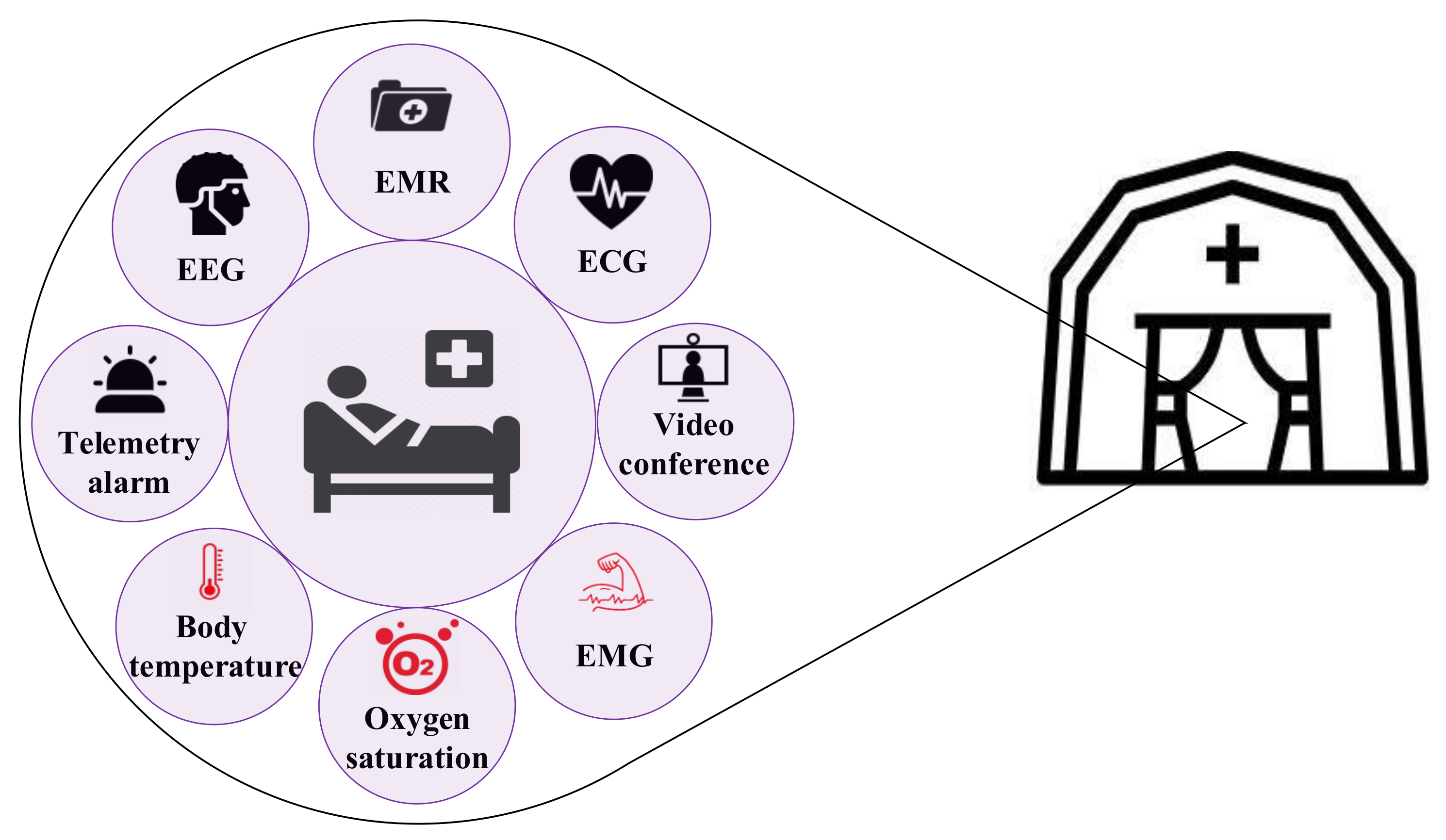
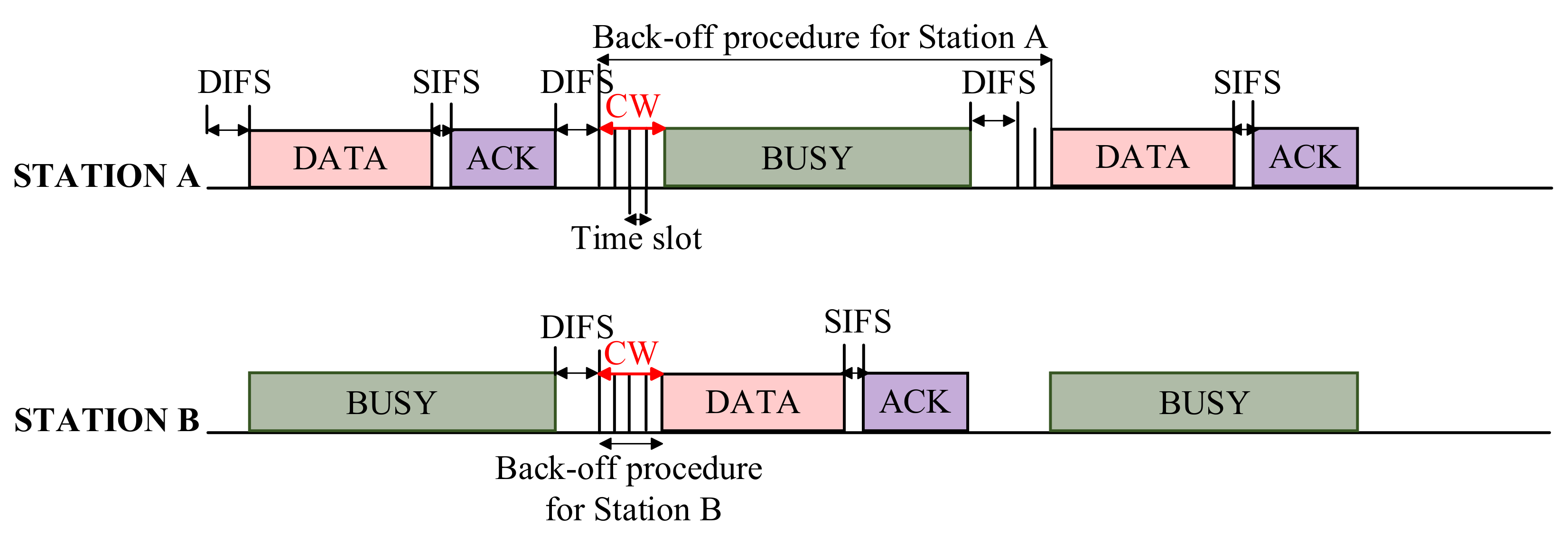

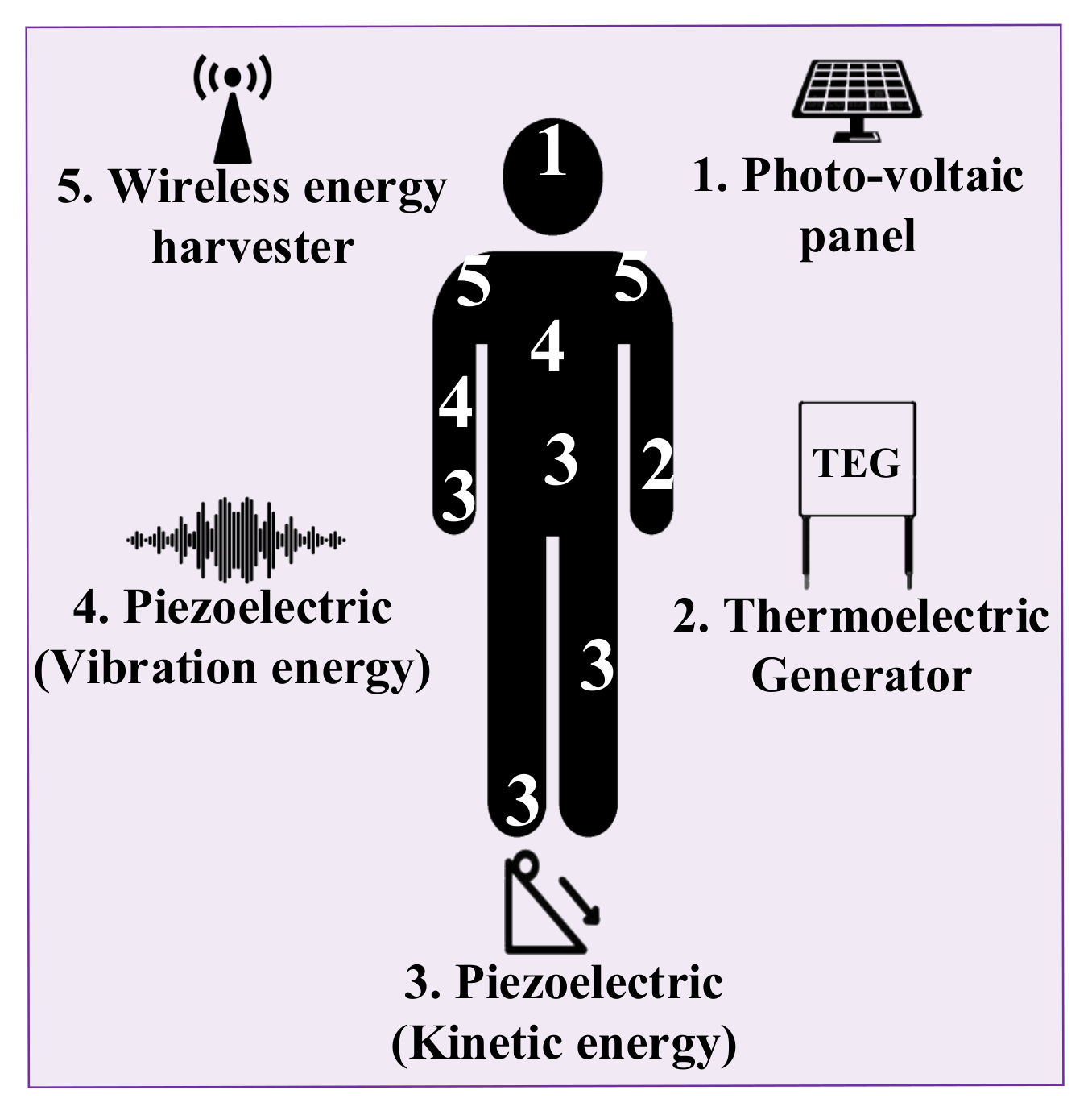
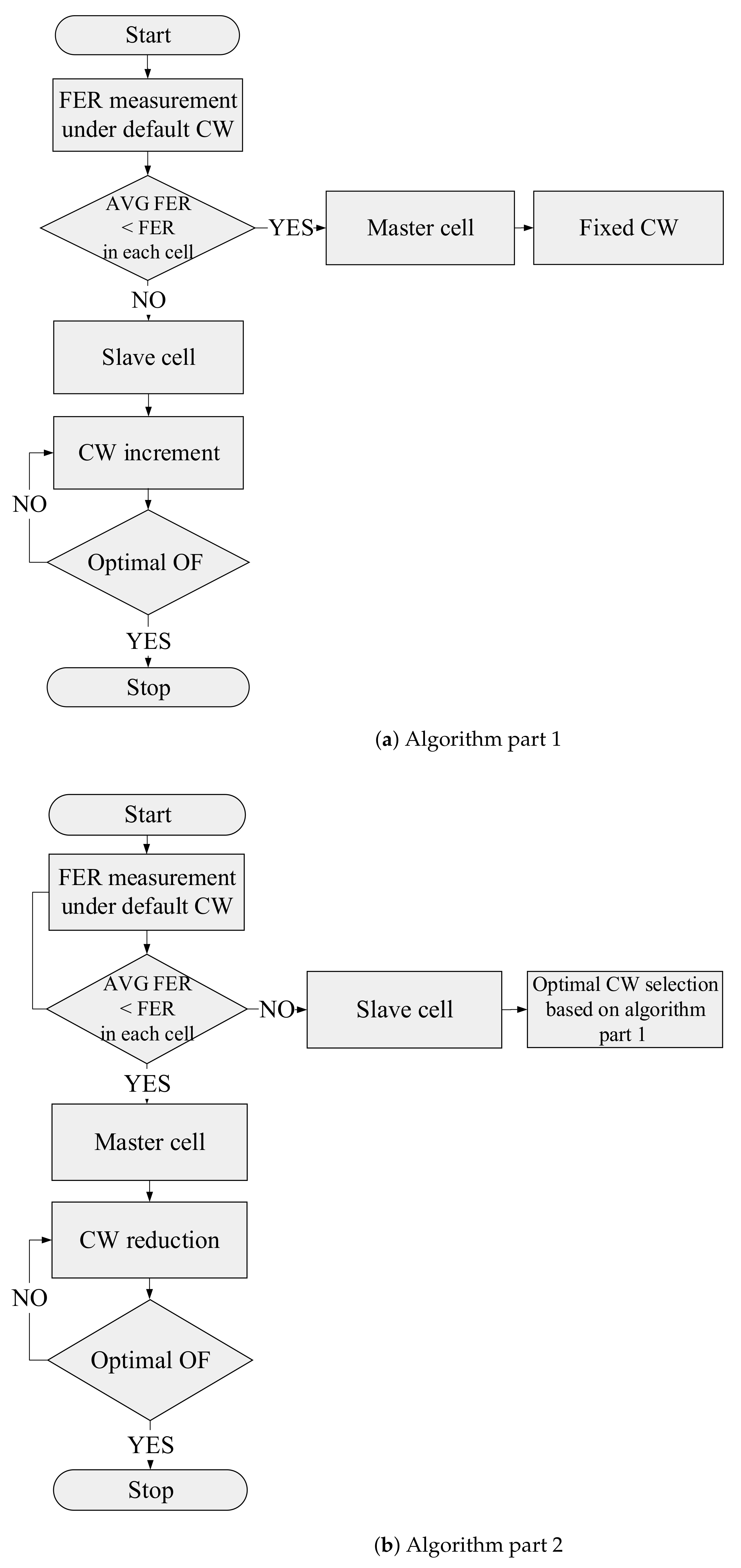
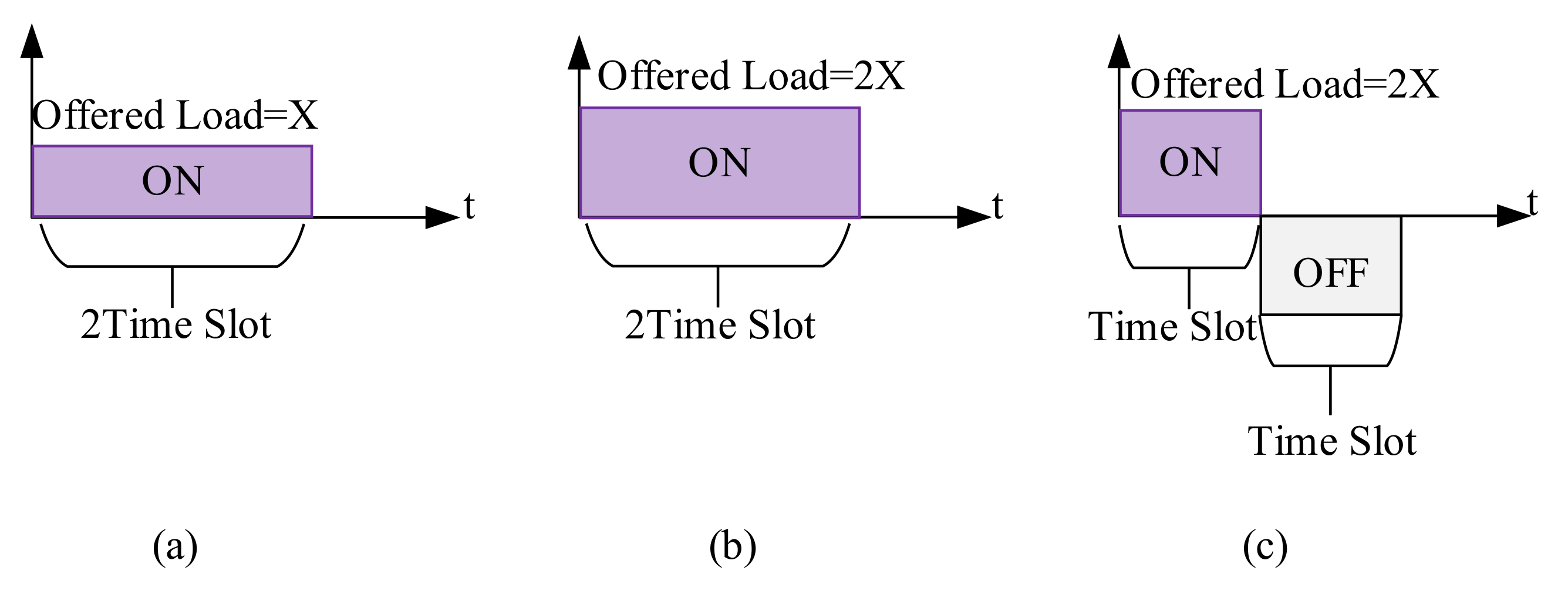
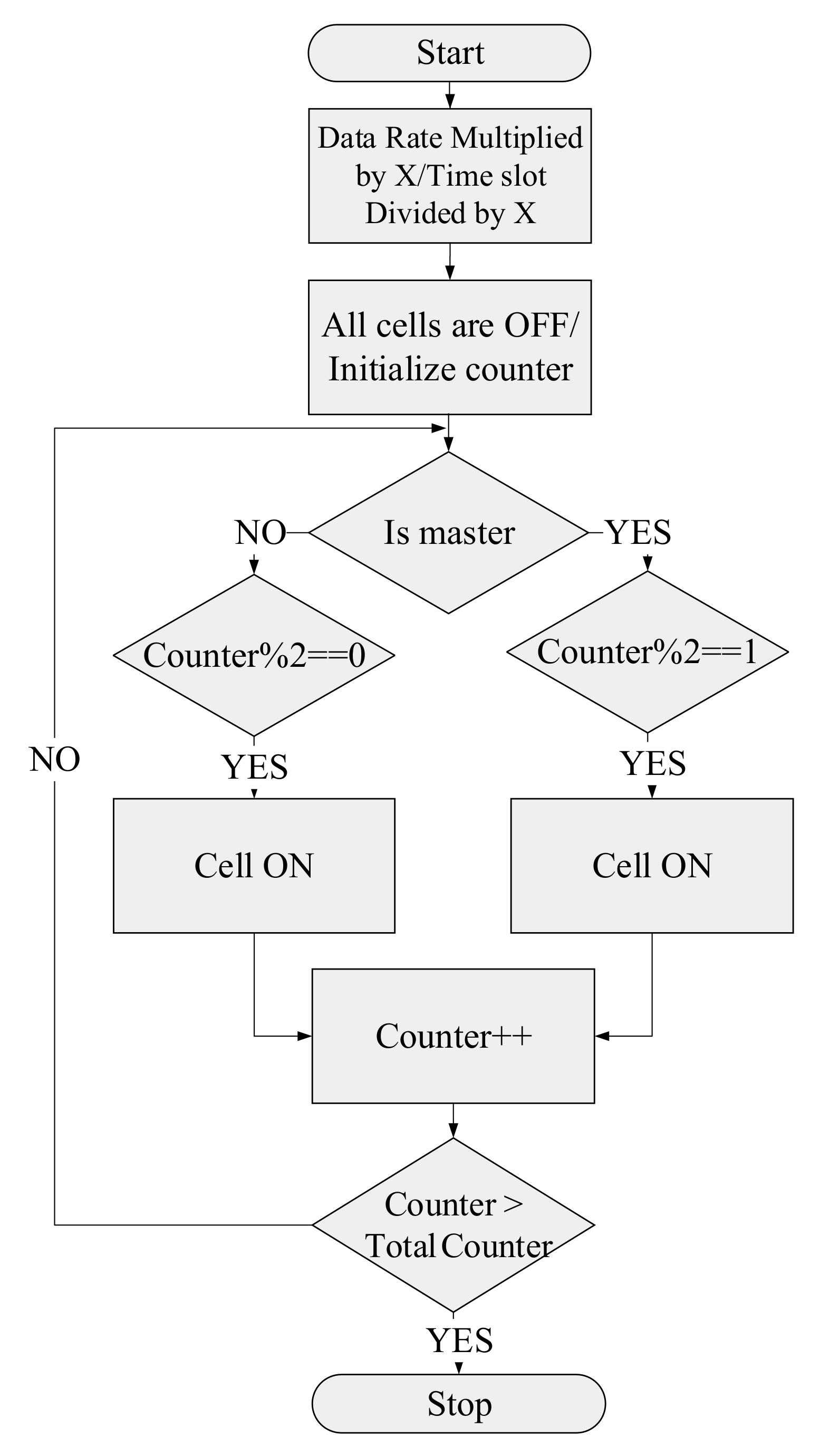
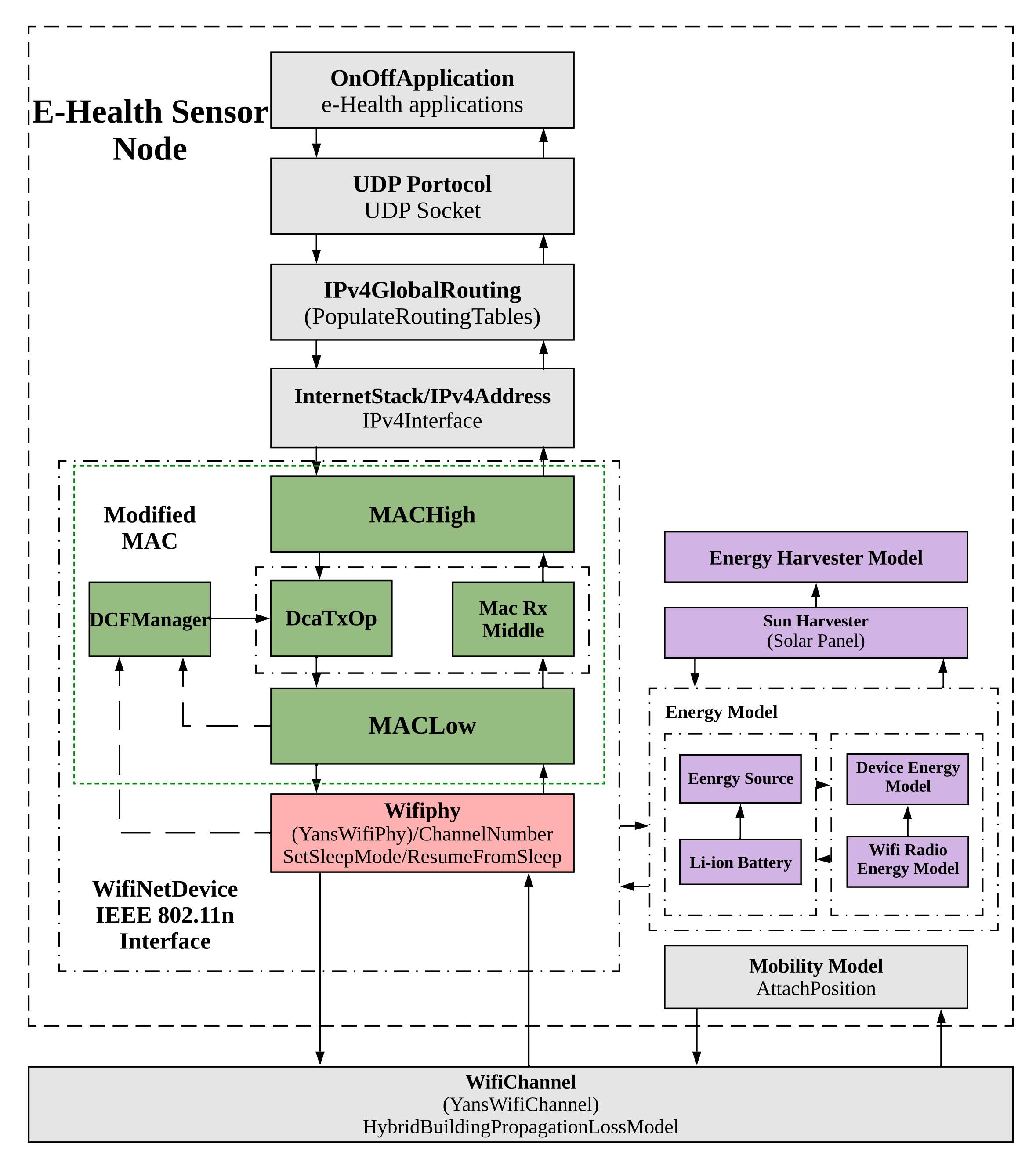
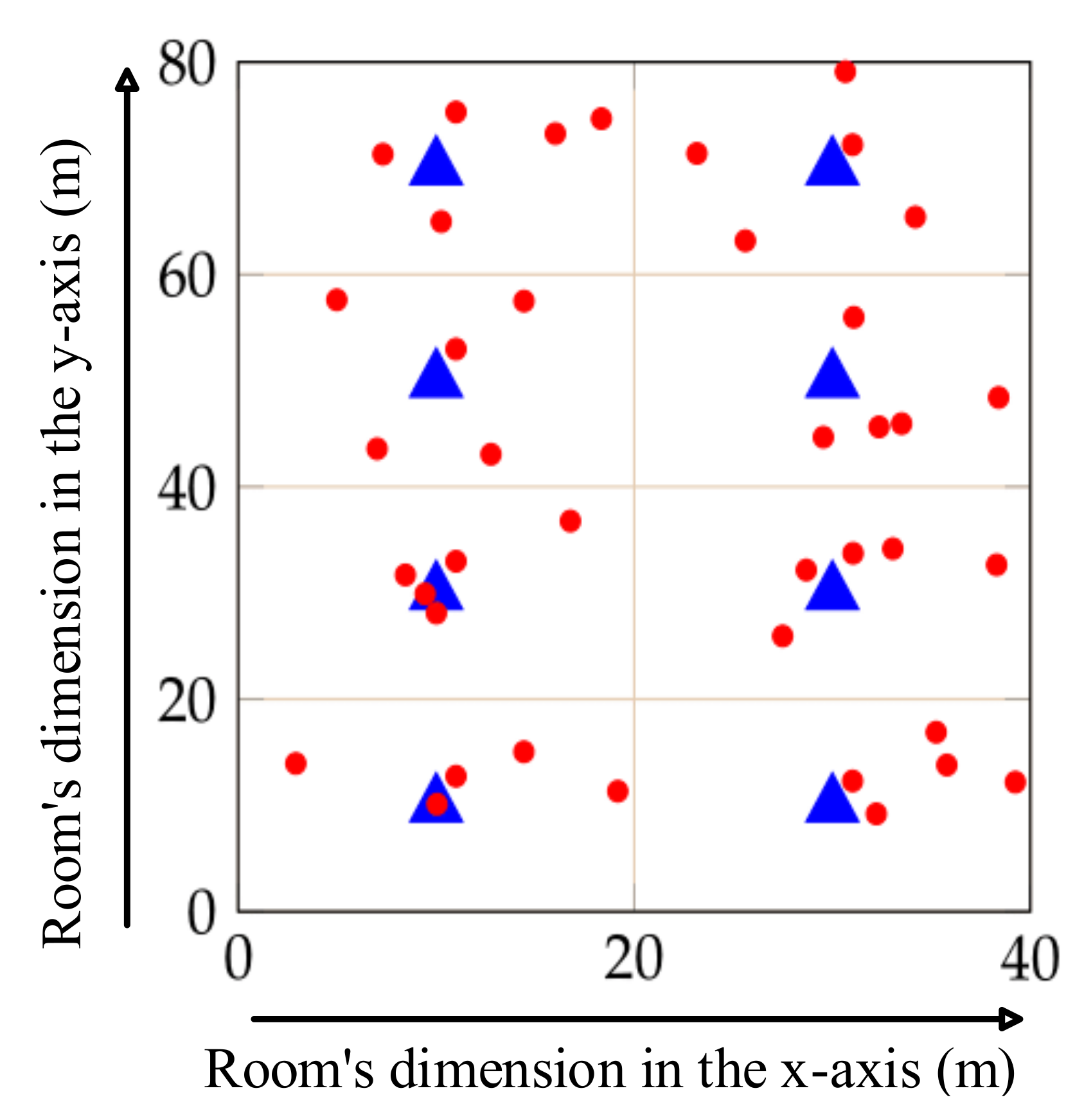
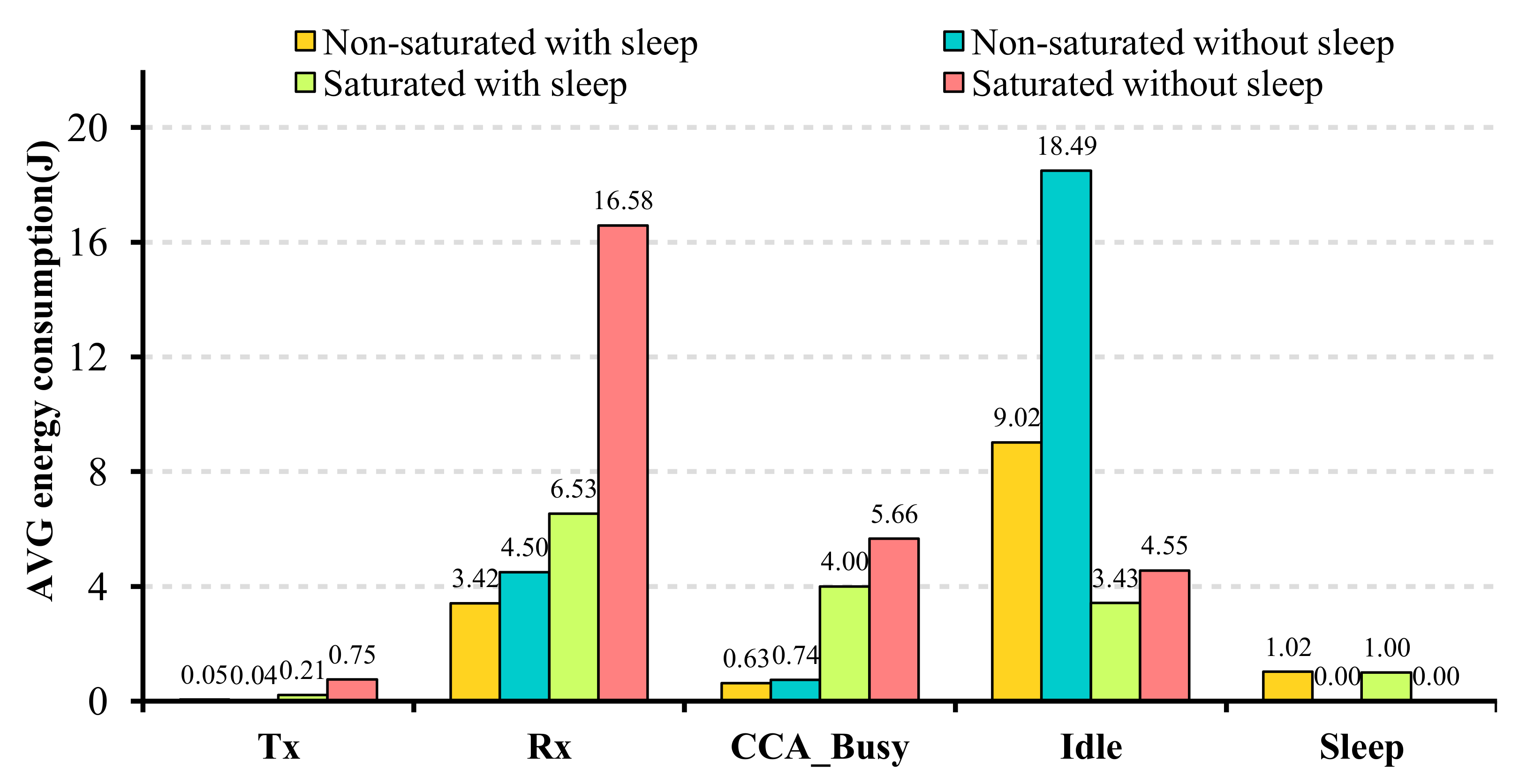
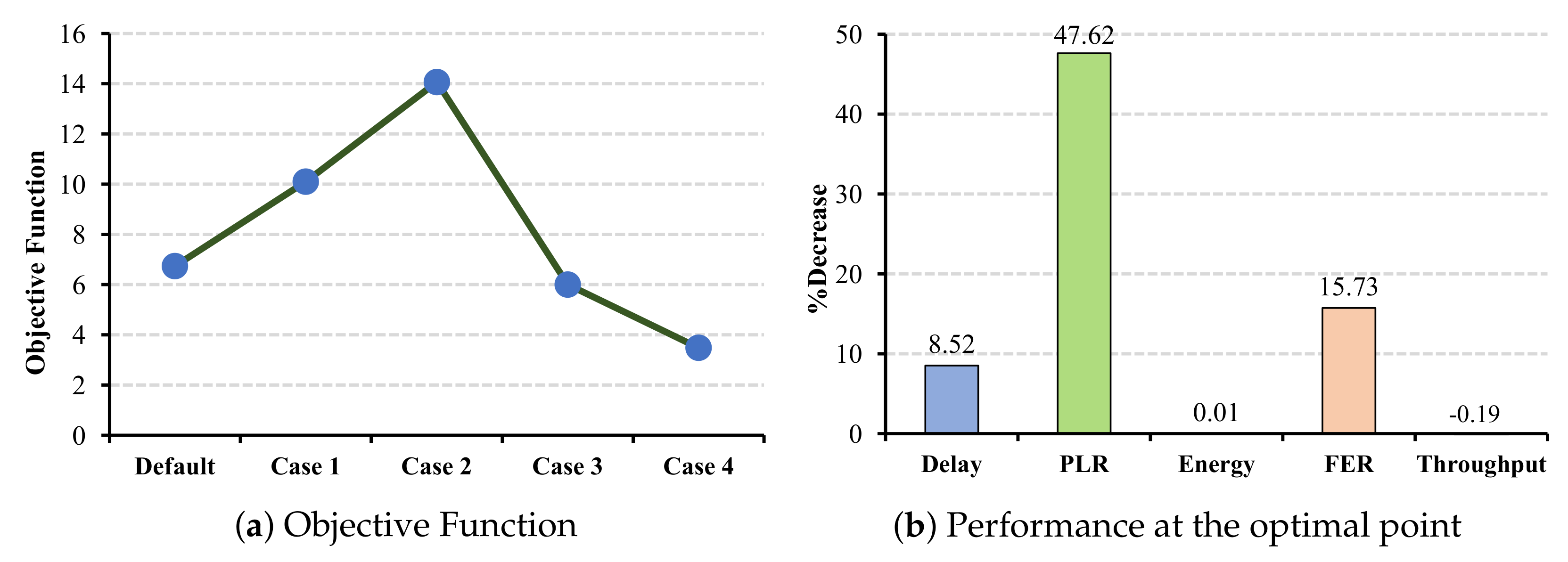

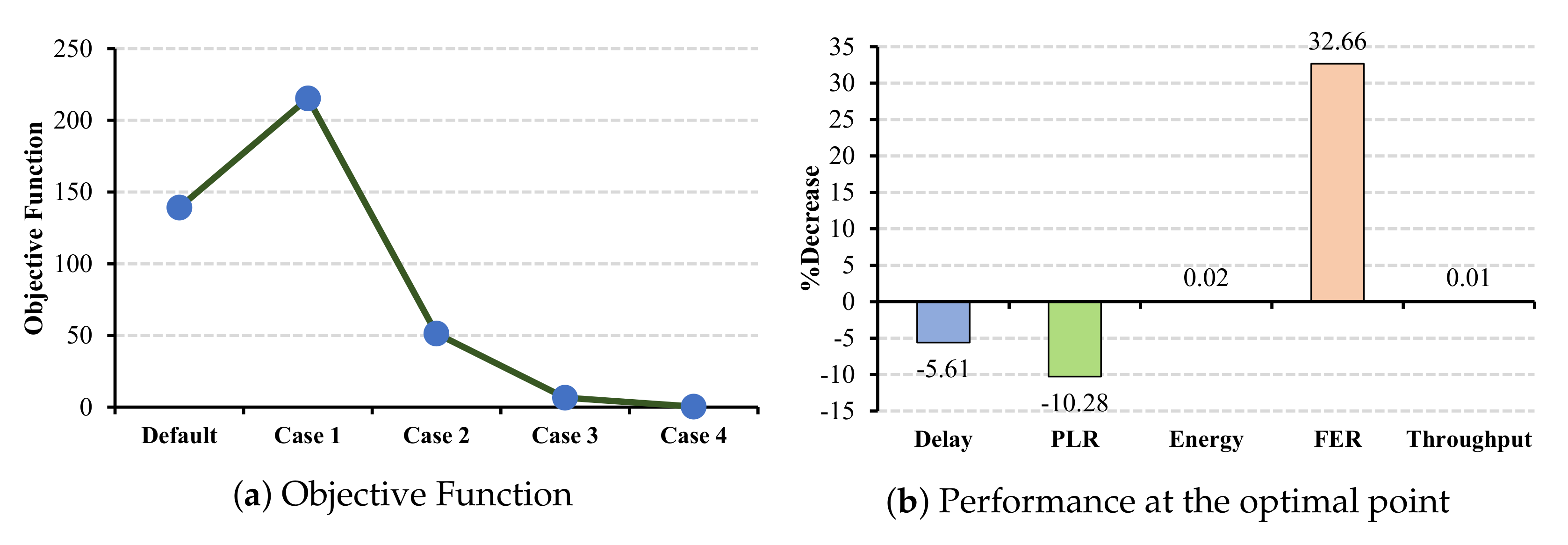
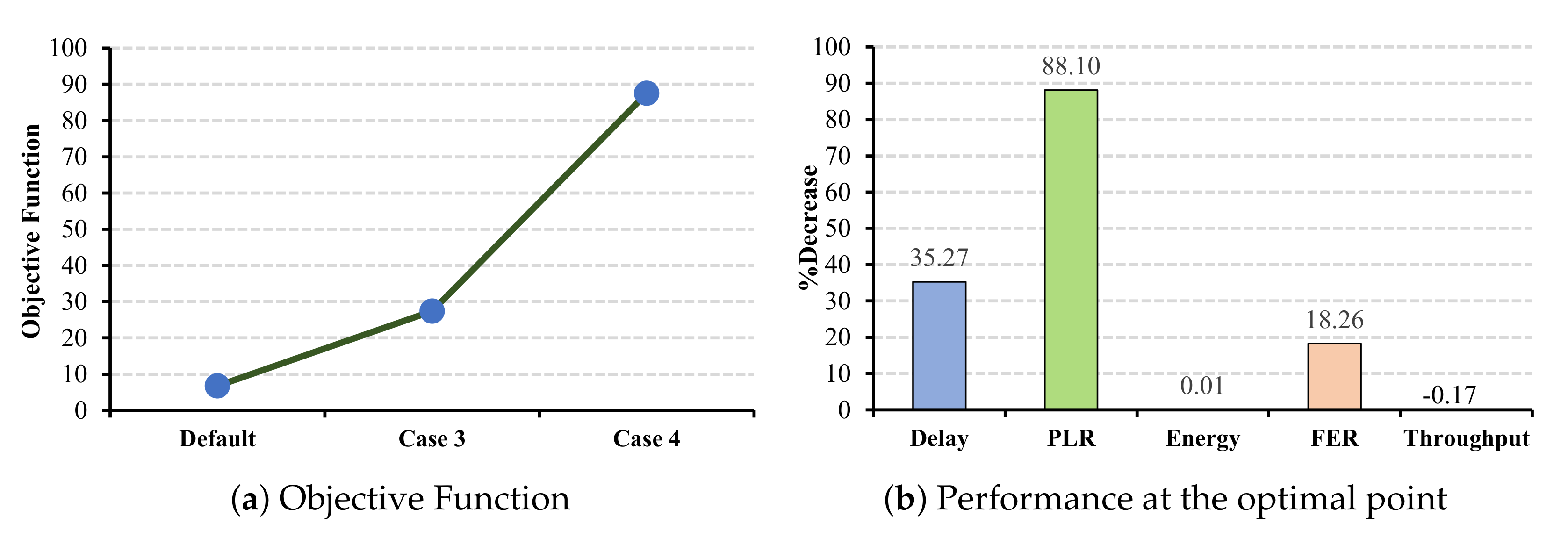
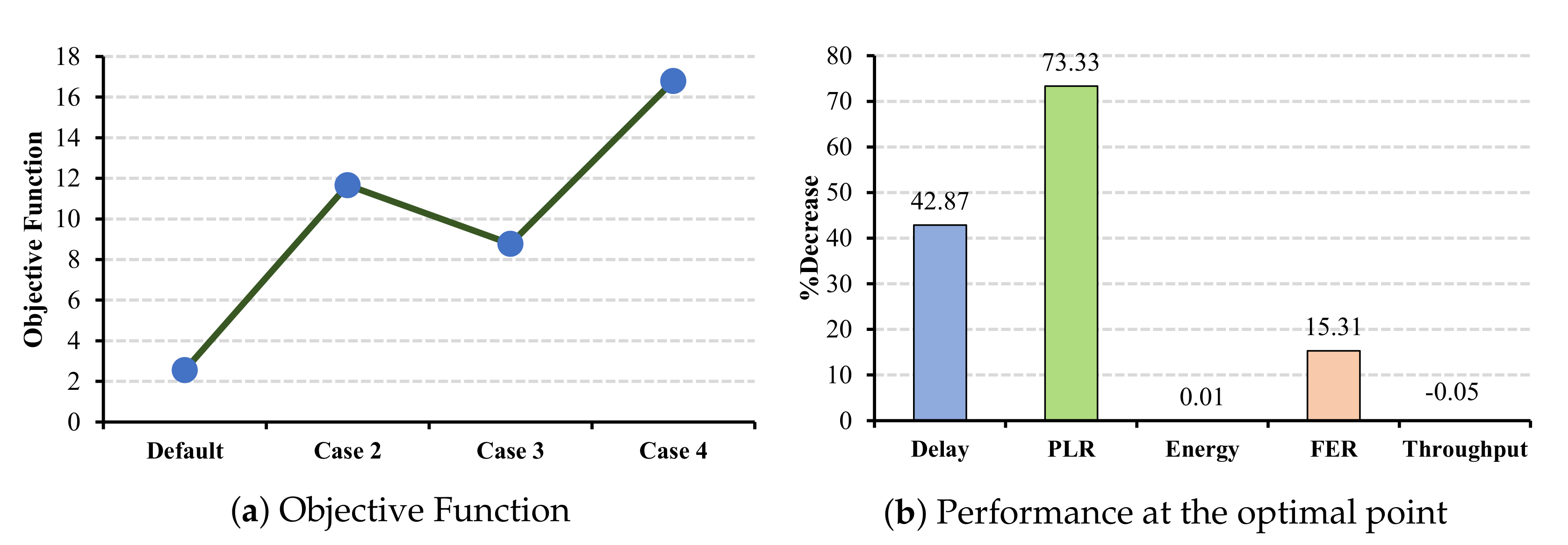
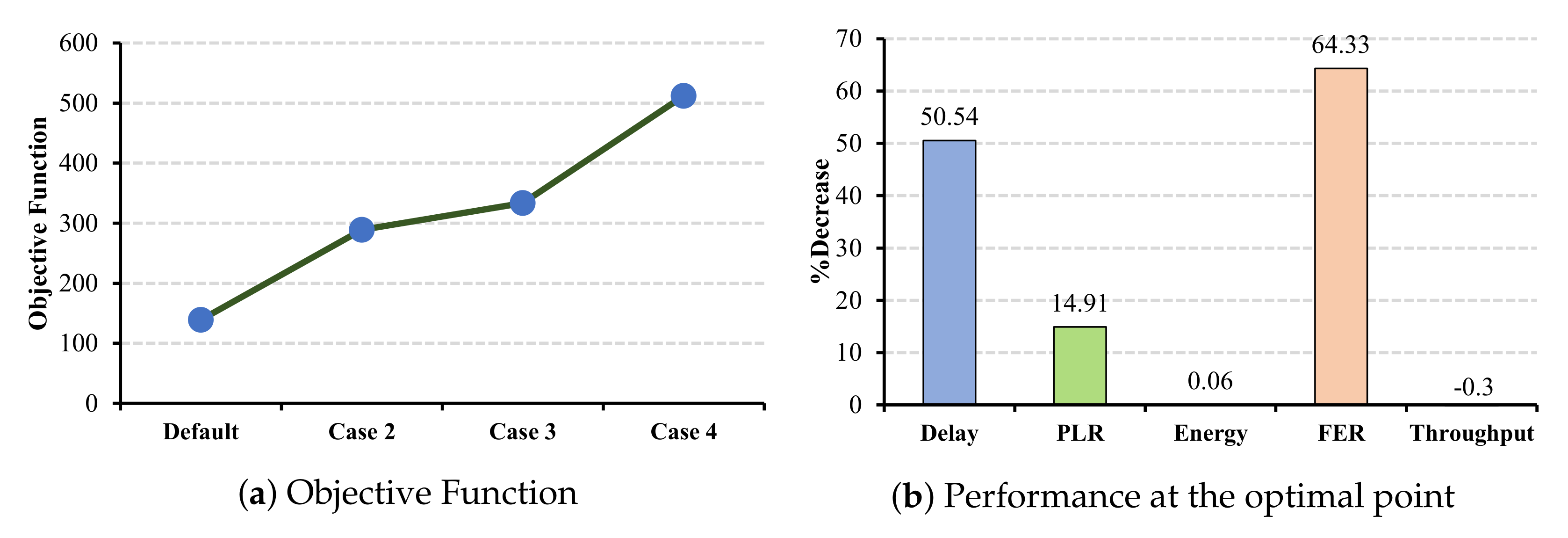

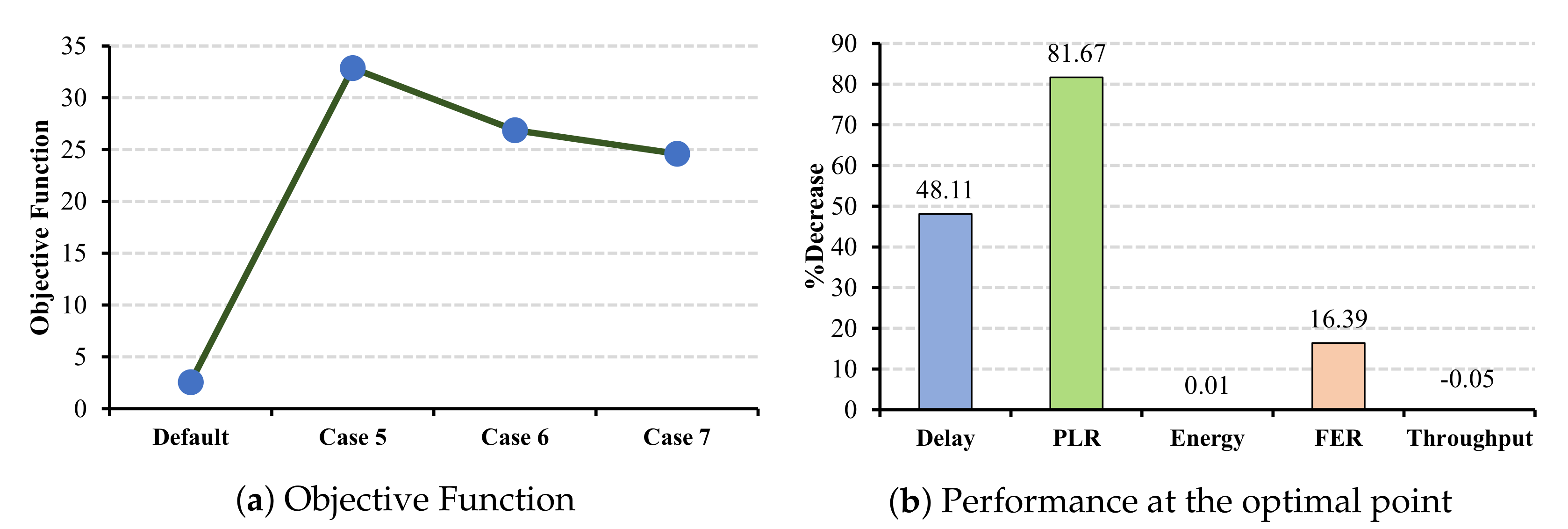
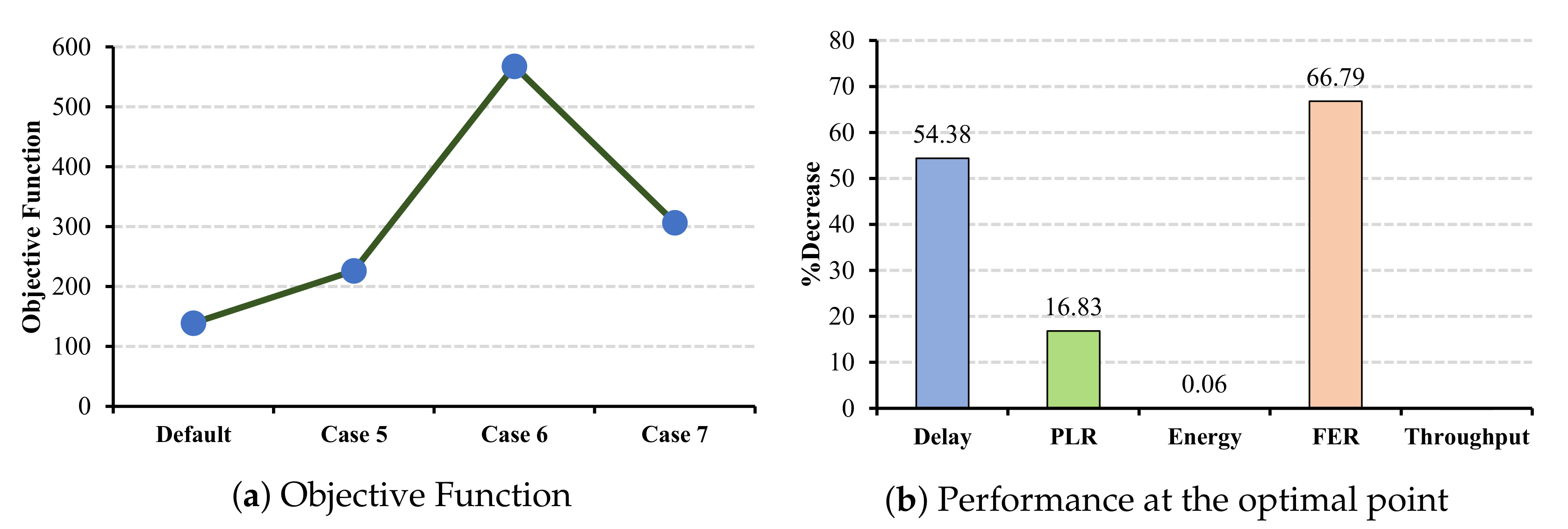
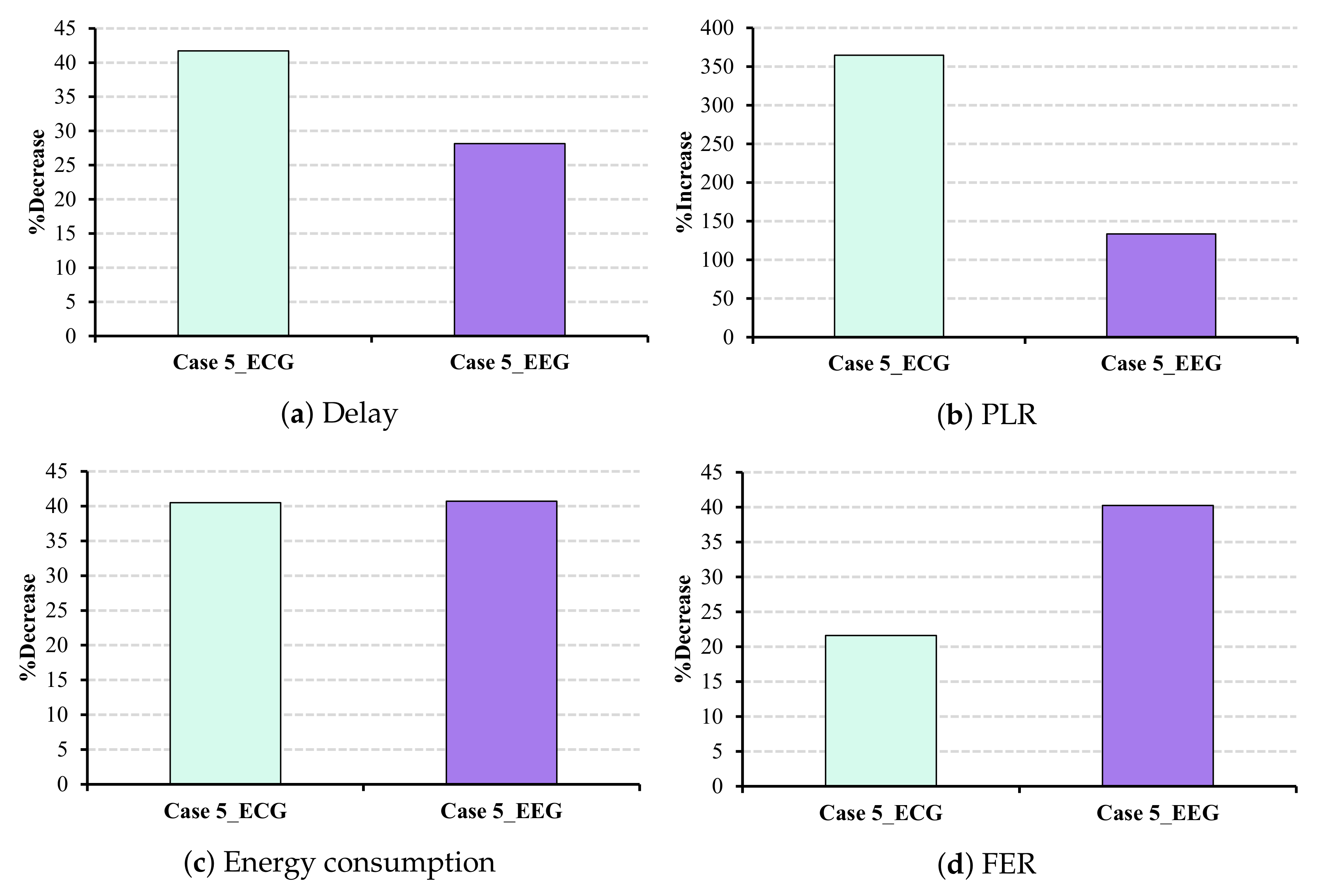
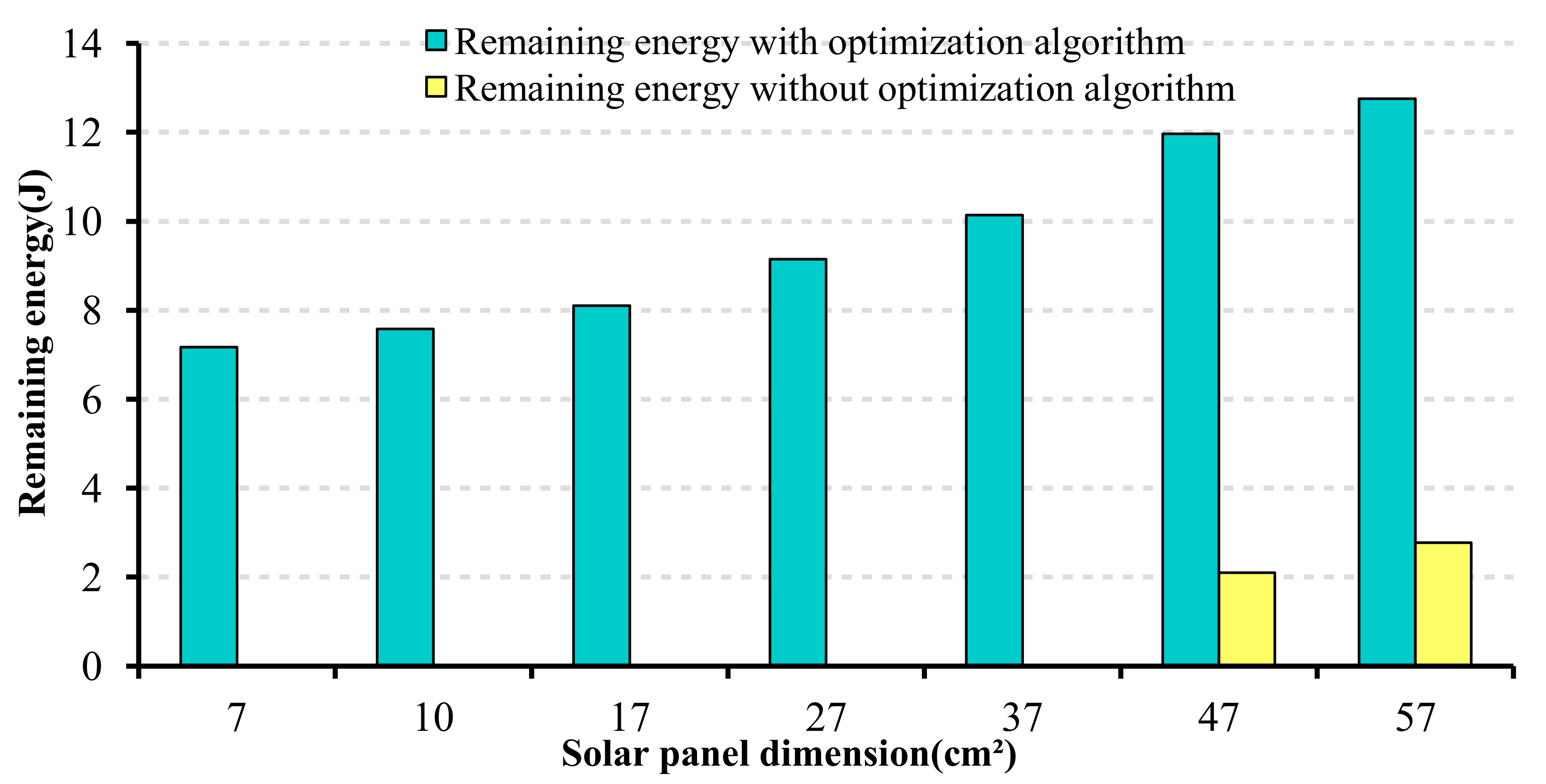
| Access Category | CW | CW | AIFSN | TXOP |
| VO | 7 | 15 | 2 | 1.5 ms |
| VI | 15 | 31 | 2 | 3.0 ms |
| BE | 31 | 1023 | 3 | 0.0 ms |
| BK | 31 | 1023 | 7 | 0.0 ms |
| Energy Source | Energy Harvester | Power Density |
|---|---|---|
| Sun radiation | Photo-voltaic cell | 10 µW/ |
| Artificial light | 100 mW/ | |
| Radio Frequency | Wireless energy | 0.1 µW/ |
| harvester | 300 µW/ | |
| Heat | Thermocouple | 40 µW/ |
| 50 mW/ | ||
| Human body motion | Piezoelectric | 0.021 µW/ |
| Vibration | 2 W/ |
| Properties |
Wireless Communication 1 |
MAC Modification |
AP Coordination |
Sleep/Wake-Up Deployment |
Energy Harvester |
QoS Support |
Dense Deployment | |
|---|---|---|---|---|---|---|---|---|
| Studies | ||||||||
| Son et al. [40] | Wi-Fi | ✓ | ✗ | ✗ | ✗ | ✓ | ✗ | |
| Tian et al. [41] | Wi-Fi | ✓ | ✗ | ✗ | ✗ | ✓ | ✗ | |
| Syed et al. [42] | Wi-Fi | ✓ | ✗ | ✗ | ✗ | ✓ | ✓ | |
| Ahmed et al. [43] | Wi-Fi | ✓ | ✗ | ✓ | ✗ | ✓ | ✓ | |
| Ali. et al. [44] | Wi-Fi | ✓ | ✗ | ✓ | ✗ | ✓ | ✓ | |
| Ali. et al. [45] | Wi-Fi | ✓ | ✗ | ✗ | ✗ | ✓ | ✓ | |
| Filoso et al. [46] | Wi-Fi | ✓ | ✗ | ✗ | ✗ | ✓ | ✓ | |
| Malche et al. [47] | BLE | ✗ | ✗ | ✓ | ✗ | ✗ | ✓ | |
| Sheela et al. [48] | Wi-Fi | ✗ | ✗ | ✗ | ✗ | ✗ | ✓ | |
| Fafoutis et al. [49] | Wi-Fi | ✓ | ✗ | ✓ | ✓ | ✗ | ✗ | |
| Lin et al. [50] | Wi-Fi | ✓ | ✗ | ✓ | ✓ | ✗ | ✓ | |
| Shafique et al. [51] | Wi-Fi | ✗ | ✗ | ✗ | ✓ | ✗ | ✓ | |
| Blobel et al. [52] | Wi-Fi | ✓ | ✗ | ✓ | ✓ | ✗ | ✓ | |
| Kim et al. [53] | Multiple | ✓ | ✗ | ✓ | ✓ | ✓ | ✗ | |
| Sarang et al. [54] | Multiple | ✓ | ✗ | ✓ | ✓ | ✓ | ✗ | |
| Kim et al. [56] | Multiple | ✓ | ✗ | ✗ | ✓ | ✗ | ✓ | |
| Naderi et al. [55] | Multiple | ✓ | ✗ | ✗ | ✓ | ✗ | ✗ | |
| Guntupalli et al. [57] | Multiple | ✓ | ✗ | ✓ | ✓ | ✗ | ✓ | |
| Our proposal | Wi-Fi | ✓ | ✓ | ✓ | ✓ | ✓ | ✓ | |
| Application Type | QoS Parameters | ||||
|---|---|---|---|---|---|
| End-to-End Delay (ms) | Required Bandwidth (Mbps) | Packet Loss Ratio (%) | Jitter (ms) | Sensitivity to Context | |
| ECG [40,65,66] | <250 | 1 | <10 | 25 | ✓ |
| EEG [40,65,66] | <250 | 1 | <10 | 25 | ✓ |
| EMR [40,67,68] | <300 | 1 | <10 | 30 | ✗ |
| Telemetry alarm [40,65] | <100 | 1 | <10 | 25 | ✓ |
| Video [69] | 150–400 | 2 | <5 | 30 | ✗ |
| Parameter | Value |
|---|---|
| Panel dimension [58] | 17 |
| Panel latitude [58] | 41.3851 |
| Panel longitude [58] | 2.1734 |
| Panel altitude [58] | 12.000 m |
| Harvesting update interval [58] | 0.100 s |
| Initial energy [77] | 100.000 J |
| Initial voltage [77] | 3.200 v |
| Nominal voltage [77] | 4.000 v |
| Exponential voltage [77] | 4.000 v |
| Rated capacity [77] | 0.950 Ah |
| Nominal capacity [77] | 1.600 Ah |
| Exponential capacity [77] | 0.200 Ah |
| Internal resistance [77] | 0.035 |
| Minimum threshold voltage [77] | 3.000 v |
| Idle current [76] | 0.233 A |
| Transmission current [76] | 0.466 A |
| Reception current [76] | 0.300 A |
| Sleep current [76] | 0.020 A |
| CCA_Busy [76] | 0.273 A |
| Combination of CW | Adapted Label in the Case of |
|---|---|
| and CW | CW Changes in All the Cells |
| 31–1023 | Default |
| 63–1055 | case 1 |
| 127–1119 | case 2 |
| 255–1247 | case 3 |
| 511–1503 | case 4 |
| Combination of CW and CW | Adapted Label in the Case of CW Changes in Master Cells |
|---|---|
| 31–1023 | Default |
| 123–1116 | case 5 |
| 119–1112 | case 6 |
| 115–1108 | case 7 |
Publisher’s Note: MDPI stays neutral with regard to jurisdictional claims in published maps and institutional affiliations. |
© 2022 by the authors. Licensee MDPI, Basel, Switzerland. This article is an open access article distributed under the terms and conditions of the Creative Commons Attribution (CC BY) license (https://creativecommons.org/licenses/by/4.0/).
Share and Cite
Famitafreshi, G.; Afaqui, M.S.; Melià-Seguí, J. Enabling Energy Harvesting-Based Wi-Fi System for an e-Health Application: A MAC Layer Perspective. Sensors 2022, 22, 3831. https://doi.org/10.3390/s22103831
Famitafreshi G, Afaqui MS, Melià-Seguí J. Enabling Energy Harvesting-Based Wi-Fi System for an e-Health Application: A MAC Layer Perspective. Sensors. 2022; 22(10):3831. https://doi.org/10.3390/s22103831
Chicago/Turabian StyleFamitafreshi, Golshan, Muhammad Shahwaiz Afaqui, and Joan Melià-Seguí. 2022. "Enabling Energy Harvesting-Based Wi-Fi System for an e-Health Application: A MAC Layer Perspective" Sensors 22, no. 10: 3831. https://doi.org/10.3390/s22103831
APA StyleFamitafreshi, G., Afaqui, M. S., & Melià-Seguí, J. (2022). Enabling Energy Harvesting-Based Wi-Fi System for an e-Health Application: A MAC Layer Perspective. Sensors, 22(10), 3831. https://doi.org/10.3390/s22103831






